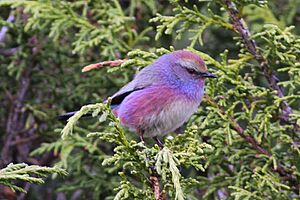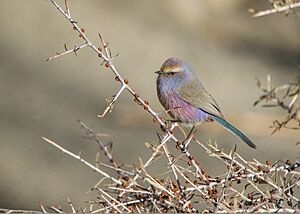White-browed tit-warbler facts for kids
Quick facts for kids White-browed tit-warbler |
|
|---|---|
 |
|
| Male of nominate subspecies | |
 |
|
| Female of nominate subspecies | |
| Conservation status | |
| Scientific classification | |
| Genus: |
Leptopoecile
|
| Species: |
sophiae
|
 |
|
| Range in green, on a map of central Asia | |
The white-browed tit-warbler (Leptopoecile sophiae) is a small, colorful bird that belongs to the bushtit family. This bird was first described in 1873 by a scientist named Nikolai Severtzov. You can find these birds living in the Tian Shan mountains and central China. They also live in the Himalayas, especially during winter. They love to live in boreal forests, which are cold, northern forests.
Contents
About the White-browed Tit-Warbler
The white-browed tit-warbler is a type of passerine bird, which means it's a perching bird. It was first officially described in 1873 by a Russian bird expert, Nikolai Severtzov.
The scientific name for this bird, Leptopoecile, comes from the Greek word leptos. This word means "slender" or "delicate." The second part of its name, sophiae, might be a tribute to Sophia Maria Alexandrovna. She was the empress of Russia when Severtzov was alive. However, it's more likely that the name honors Severtzov's wife, Sofia Alexandrovna Poltoratskaya. She joined him on an expedition and helped collect plants and insects. She also made many sketches.
Different Types of White-browed Tit-Warblers
Scientists recognize four different types, or subspecies, of the white-browed tit-warbler:
- L. s. sophiae (Severtzov, 1873) – This is the original type. It lives from southeast Kazakhstan to northwest China, and also in northwest India and northern Pakistan.
- L. s. stoliczkae (Hume, 1874) – You can find this type in China, specifically in south Xinjiang, west Qinghai, and extreme west Xizang provinces. It has the lightest feathers of all the subspecies. Its light brown tummy feathers cover a larger area. This subspecies is named after Ferdinand Stoliczka, a Czech zoologist.
- L. s. major (Menzbier, 1885) – This type lives in west Xinjiang and north Qinghai province in China. Its feathers are lighter than the original type, but still darker than L. s. stoliczkae. It prefers lower areas with thick forests. The word Major means "great" in Latin.
- L. s. obscurus (Przewalski, 1887) – This type is found in central Nepal, south and southeast Xizang, and south and east Qinghai. It also lives in south Gansu and Sichuan provinces in China. It prefers higher places in moist mountain areas. Its feathers are darker than the original type, with a more reddish-brown crown (top of the head). Sometimes, this type mixes with the original type where their homes overlap. The word Obscurus means "dark" in Latin.
The exact places where each type lives are not fully known. The original type and L. s. obscurus are similar because they are dark and live in high mountains. The L. s. major and L. s. stoliczkae types are lighter and live in lower areas. Because they live in different environments and look a bit different, some scientists think they might actually be two separate species.
What They Look Like
These birds are quite small. They weigh about 6 to 8 grams (which is less than a quarter) and are about 8.5 to 10 centimeters long (about the length of your finger).
Male white-browed tit-warblers are very colorful. They have bright blue-purple feathers on their undersides. Both males and females have a light brown crown (the top of their head) and a white stripe above their eye, like an eyebrow. Their rump (the area above their tail) and upper tail feathers are violet-blue.
Female birds are usually less colorful than males. You can tell them apart because females have pale undersides, while males have those striking violet-blue undersides and chest. They also have a fairly long tail.
Where They Live
The white-browed tit-warbler likes to live in dry, mountainous areas with shrubs. They are found at high altitudes, usually between 2,000 and 5,000 meters (about 6,500 to 16,400 feet) above sea level.
Their home range includes the Himalayas, the Tibetan Plateau, and a large part of Northwest China. When winter comes, they often move to lower elevations where it's not as cold. One study found that they are part of a "middle-mountain forest steppe community" in the Tian Shan mountain range. In Karakoram National Park, they were found to be uncommon residents, but more birds arrived during winter.
Behavior and Life
White-browed tit-warblers usually live in pairs when they are raising their young. But after the breeding season, they will join large groups of 25 or more birds. In winter, these groups might even include other types of birds.
Reproduction and Nesting
A study in the mountains of Tibet showed that white-browed tit-warblers start breeding earlier than most other songbirds in the area. They usually begin in early April and continue through July. The higher up in the mountains they are, the later they start breeding.
These birds are monogamous, meaning one male and one female stay together. Both parents help with building the nest and raising the chicks. Their nests are shaped like a dome and are built in shrubs, about 0.9 meters (3 feet) off the ground. Both the male and female work together to build the nest, which takes about two weeks.
They usually lay four to six whitish eggs with red-brown spots on the tips, but sometimes they can lay up to nine eggs. Each egg weighs about 1.14 grams. The eggs are about 15.6 by 11.6 millimeters in size. The parents take turns sitting on the eggs for about 20.5 days until they hatch. On average, 4.3 eggs hatch, but only about 3.8 chicks survive until they are ready to leave the nest. This happens when they are around 17.5 days old. Chicks born later in the season tend to have more females. When the chicks hatch, they are naked and their eyes don't open until they are about 7 days old. At this age, you can tell if they are male or female.
The Tibetan study also noticed something unusual: sometimes two females would help at one nest. This might mean that these birds sometimes practice cooperative breeding, where more than just the parents help raise the young. This idea is supported by finding cases of "egg dumping." This is when a female lays her eggs in another bird's nest, but not to trick the other bird into raising her young (which is called brood parasitism). However, cooperative nesting is rare, happening in less than 1% of nests. This is much less common than in a related bird, the black-throated bushtit, where it happens in 50% of nests.
What They Eat
Their main diet consists of small insects and spiders. They mostly catch these on the ground. They are very active hunters, searching under roots and rocks. Sometimes, they might catch insects while flying. In colder months, they also eat a small amount of seeds and berries. Baby chicks are fed only insects.
How They Survive
Not many nests fail because of predators. Only about 34% of nests are lost to predators, which is much lower than the average of 80% for birds in similar places. This might be because their nests are very well hidden, or simply because there aren't many predators around.
Even though they live in very cold places, these birds don't have a special blood vessel called the arteria ophthalmica externa. Many birds that live in cold climates have this vessel routed through their skull to help them save body heat. The fact that white-browed tit-warblers don't have it suggests they have other ways to stay warm in their chilly environment.
Status
A study in Tibet found that the number of nests significantly dropped between 2005 and 2007. However, the exact reason for this sharp decline was not clear.



